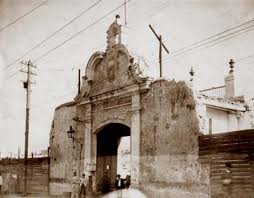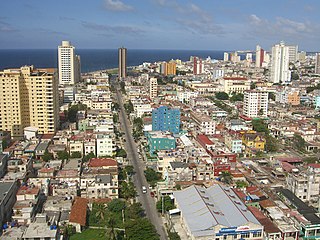
Havana is the capital and largest city of Cuba. The heart of the La Habana Province, Havana is the country's main port and commercial center. It is the most populous city, the largest by area, and the second largest metropolitan area in the Caribbean region. The population in 2002 was 2,137,847 inhabitants, and its area is 728.26 km2 (281.18 sq mi) for the capital city side and 8,475.57 km2 for the metropolitan zone.
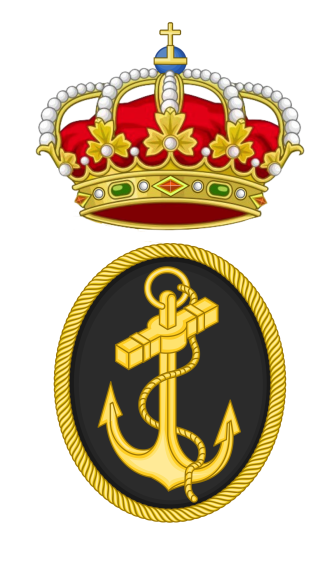
The Spanish Navy or officially, the Armada, is the maritime branch of the Spanish Armed Forces and one of the oldest active naval forces in the world. The Spanish Navy was responsible for a number of major historic achievements in navigation, the most famous being the discovery of America and the first global circumnavigation by Elcano. For several centuries, it played a crucial logistical role in the expansion and consolidation of the Spanish Empire, and defended a vast trade network across the Atlantic Ocean between the Americas and Europe, and the Manila Galleon across the Pacific Ocean between the Philippines and the Americas.
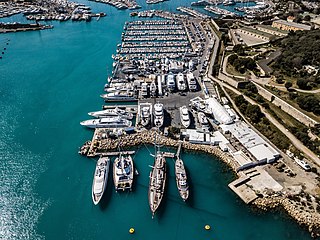
A shipyard, also called a dockyard or boatyard, is a place where ships are built and repaired. These can be yachts, military vessels, cruise liners or other cargo or passenger ships. Compared to shipyards, which are sometimes more involved with original construction, dockyards are sometimes more linked with maintenance and basing activities. The terms are routinely used interchangeably, in part because the evolution of dockyards and shipyards has often caused them to change or merge roles.
Navantia is a Spanish state-owned shipbuilding company that builds vessels for the military and civil sectors. It is the fifth-largest shipbuilder in Europe and the ninth-largest in the world. The company is the result of the segregation of the military assets of the IZAR Group in 2005. The company designs, builds, and supports all types of surface vessels, submarines, and systems. In addition, it is diversifying into new markets such as renewable energy, the offshore industry, and naval services.

Old Havana is the city-center (downtown) and one of the 15 municipalities forming Havana, Cuba. It has the second highest population density in the city and contains the core of the original city of Havana. The positions of the original Havana city walls are the modern boundaries of Old Havana.

Jorge Juan y Santacilia was a Spanish mariner, mathematician, natural scientist, astronomer, engineer, and educator. He is generally regarded as one of the most important scientific figures of the Enlightenment in Spain. As a military officer, he undertook sensitive diplomatic missions for the Spanish crown and contributed to the modernization and professionalization of the Spanish Navy. In his lifetime, he came to be known as el sabio español. His career as a public servant constitutes an important chapter in the Bourbon Reforms of the 18th century.
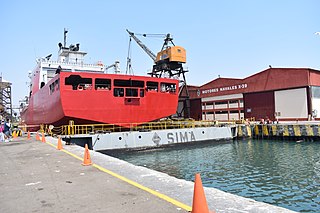
Servicios Industriales de la Marina S.A., well known as SIMA or SIMA PERU S.A., is a Peruvian shipyard that operates as a state owned company established under private law in 1950 pursuing the activities of the former Naval Factory founded in 1845, and continually extending its operational capacity, first to the shipbuilding which SIMA pioneered in South America and then to the greatest metalworking structures manufacture, contributing to the defense and socio-economic development of Peru. The SIMA mainly serve the Navy of Peru as well as domestic and foreign private clients through a wide range of products.

Havana was founded in the sixteenth century displacing Santiago de Cuba as the island's most important city when it became a major port for Atlantic shipping, particularly the Spanish treasure fleet.

José Romero y Fernández de Landa (1735–1807), better known as Romero Landa was a Spanish naval and army officer and the Spanish Navy's first official naval engineer and ship designer. He designed several two-and three-deck ships of the line in the late 18th and early 19th centuries which fought at the Battle of Cape St Vincent and the Battle of Trafalgar.

The Arsenal de Marinha do Rio de Janeiro (AMRJ) is a military organization of the Brazilian Navy. It is located in Ilha das Cobras, at the Guanabara Bay, in the city of Rio de Janeiro. The Arsenal is the main maintenance center and naval base of the Brazilian Navy, involving the design, construction and maintenance of ships and submarines, not only for the Brazilian Navy, but also friendly nations.

A patache is a type of sailing vessel with two masts, very light and shallow, a sort of cross between a brig and a schooner, which originally was a warship, being intended for surveillance and inspection of the coasts and ports. It was used as a tender to the fleet of vessels of more importance or size, and also for trans-Pacific travel, but later began to be used for trading voyages, carrying cargo burdens of 30 tons or more.
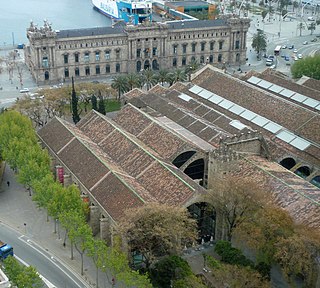
The Barcelona Royal Shipyard is a shipyard and former military building of Gothic architecture placed at the Port Vell area of the Port of Barcelona. Today it houses the Barcelona Maritime Museum. Construction started during the 13th century under the rule of Peter III of Aragon. During excavations in 2012 it was discovered that in the late 16th century a new building was constructed on top of the old medieval dockyard, giving the building its current structure. These excavations also uncovered a Roman graveyard. The shipyard's restoration was finished in early 2013. The museum was reopened in 2014.

The Castillo del Príncipe is a military fort located in the Loma de Aróstegui, in Havana, Cuba. In 1982, the fort was inscribed on the UNESCO World Heritage List, along with other historic sites in Old Havana, because of the city's importance in the European conquest of the New World, its fortifications, and its unique architecture.

Arsenal de la Carraca, also Naval Station of La Carraca, is a naval shipyard and a naval base in San Fernando, Spain. It is a naval base for the construction and repair of ships, and the storage and distribution of arms and ammunition. The first military establishment of its kind to be created in Spain under the naval policy of Felipe V, it was developed by Patiño and the Marquis de la Ensenada. Though work on building the shipyard began in 1720, the formal decree issued by Fernando VI on October 3, 1752, accelerated its construction until it was completed in the late 18th century.
The Armada de Barlovento was a military formation that consisted of 50 ships created by the Spanish Empire to protect its overseas American territories from attacks from its European enemies, as well as attacks from pirates and privateers.

The Battle of Sabana Real took place on January 21, 1691. An army of 700 Dominican raiders and 2,600 militiamen aboard five warships of the Armada de Barlovento, circled and overwhelmed 1,000 French defenders at Sabana de la Limonade; Governor de Cussy and 400 of his followers were killed.

The Parque de la Fraternidad was built in the 1790s as a military practice range by the Spanish government, It was expanded in 1793 by Belgian engineer Agustin Cramer, and later Bishop Espada improved the lighting of the Campo. It was Captain General Don Miguel Tacón who included it within the scope of his embellishment program. The area was then fenced and four majestic gates, crowned with coats of arms, each representing an important personality: the north gate, Hernán Cortés; the south one, Francisco Pizarro; and the east and west gates, Captain General Miguel Tacón y Rosique (1834–1838), and Christopher Columbus respectively.

The Quinta de Los Molinos is more than two centuries old and a national monument, an oasis in the heart of the city located at the intersection of one of Havana’s heaviest traffic arteries: Infanta, Carlos III, and Boyeros avenues. The Quinta since colonial times has had a complicated history to various events and characters, mainly with General Máximo Gómez.
Pedro Velaz de Medrano y Manso de Zúñiga, II Lord of Tabuérniga was the captain general of the Armada de Barlovento and custodian of the Fleet of New Spain, governor of the Tercio of Álava, governor of five galleons from Naples, sailor and prominent Spanish noble during the reign of Felipe IV. He is famous for having captained a French corsair flotilla in the Caribbean with the intention of capturing the Spanish treasure fleet for King Louis XIV of France. He married María de Altamirano y Ponce de León. His son Don Antonio Velaz de Medrano y Altamirano, Governor of the strategic city of Nieuwpoort became the I Marquis of Tabuerniga, granted by King Carlos II of Spain in 1682.


